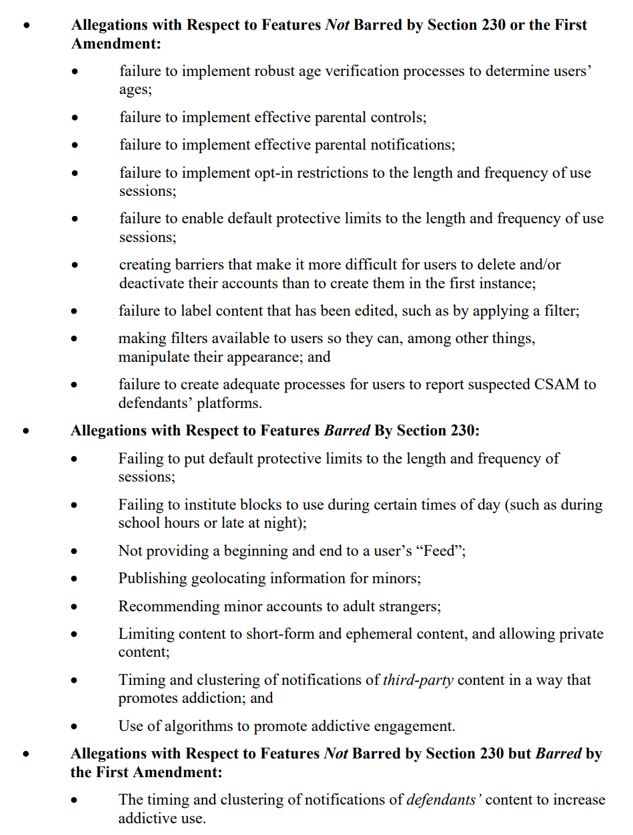Recapping Three Social Media Addiction Opinions from Fall (Catch-Up Post)
 The Northern District of California issued three opinions, totaling over 150 pages, in rapid succession over 3 weeks last Fall. The opinions came out faster than I could blog them. I’m not going to comprehensively blog each of the opinions, but I’ll round up some highlights here to get these out of my queue.
The Northern District of California issued three opinions, totaling over 150 pages, in rapid succession over 3 weeks last Fall. The opinions came out faster than I could blog them. I’m not going to comprehensively blog each of the opinions, but I’ll round up some highlights here to get these out of my queue.
At this point, I’ve not paid close attention to the proceedings because everything at the district court level is a rehearsal for the inevitable appellate court review. A reminder: this lawsuit is a battle royale. Each side has phalanxes of lawyers, and no point is too picayune to spar over. I’m sure the appellate court will be eager to docket this one. They will need to clear their calendar.
In re. Social Media Adolescent Addiction/Personal Injury Products Liability Litigation, 2024 WL 4532937 (N.D. Cal. Oct. 15, 2024)
The court partially summarizes the scope of this opinion:
Meta’s alleged yearslong public campaign of deception as to the risks of addiction and mental harms to minors from platform use fits readily within these states’ deceptive acts and practices framework. Meta’s design, development, and deployment of certain product features plausibly constitutes unfair or unconscionable practices under all at-issue federal and state standards. However, as before, Section 230 provides a fairly significant limitation on these claims. Section 230 insulates the design and deployment of most features alleged to be unfair or unconscionable. Similarly, Section 230 protects against personal injury plaintiffs’ consumer-protection, concealment, and misrepresentation theories to the same extent.
Combined with prior rulings, in the October 24, 2024 ruling, the court summarizes where the various claims stand:
It’s even more complicated, because several of the plaintiffs’ claims are based on state laws. With Section 230 out of the picture, the opinion must march through a multi-state analysis for various claims. There is so much going on, it takes the court 3 pages to summarize all of this opinion’s conclusions.
In re. Social Media Adolescent Addiction/Personal Injury Products Liability Litigation, 4:22-md-03047-YGR (N.D. Cal. Oct. 24, 2024)
This ruling involves the school districts’ claims against social media for their alleged role in providing resource-intensive mental health support for students. This claim especially blows my mind, because psychologists keep telling us that children’s mental health is being stressed from many sources, including several attributable to the government’s failings (e.g., inadequate attention to climate change, COVID protocols, uncertain job prospects, government’s express targeting of people based on immutable attributes (e.g., the culture wars), the slide of our republic into fascism, etc.). Further, social media is part of the mental health solution for some children, and their mental health could counterproductively demand more resources from school districts if the plaintiffs succeed.
The court says:
plaintiffs’ core theory of injury suffices to establish proximate cause at the pleading stage: as alleged, defendants’ conduct deliberately fostered compulsive use of their platforms which foreseeably caused the plaintiff school districts to respond by expending resources to mitigate the impact of such use in their schools. This core theory of injury focuses on the impact of compulsive use itself, irrespective of third-party content, defendants’ protected publishing activity and defendants’ protected first-party speech. As to any alleged injuries to the school districts stemming from dangerous challenges, threats, and crimes disseminated or perpetrated on defendants’ platforms caused by deteriorated youth mental health, those allegations fail proximate causation for a lack of particularized allegations. However, such allegations are not barred to the extent defendants promoted, developed, or participated in a foreseeably dangerous challenge, beyond the algorithmic publication, curation, or amplification of that third-party challenge
The net effect is that the school districts get to stay in the case, at least for now.
In re. Social Media Adolescent Addiction/Personal Injury Products Liability Litigation, 2024 WL 4719068 (N.D. Cal. Nov. 7, 2024)
The plaintiffs named Zuckerberg as a defendant individually. The district court initially dismissed that claim in April 2024 but gave the plaintiffs another chance. They tried again, to no avail. To “establish corporate-officer liability, plaintiffs here must allege that Zuckerberg directed, sanctioned, or participated in Meta’s concealment of this information.” The plaintiffs don’t meet this standard: “Plaintiffs fail to allege any instance where Zuckerberg directed the suppression of material information.”
BONUS: Commonwealth v. Meta Platforms, Inc., 2024 Mass. Super. LEXIS 161 (Mass. Superior Ct. Oct. 17, 2024)
Massachusetts claims that Instagram constitutes a public nuisance and lies to its users. The court rejected Facebook’s motion to dismiss.
Section 230
 The court says that Section 230 doesn’t apply to Facebook’s own deceptive statements.
The court says that Section 230 doesn’t apply to Facebook’s own deceptive statements.
With respect to Instagram’s design attributes:
The Commonwealth alleges physical and mental harm to young users from lnstagram’s design features themselves, which purportedly cause addictive use, and not from the viewing of any specific third-patty content or from design choices th at contributed to the development or creation of that content. In other words, the alleged harm occurs regardless of the content that users see. As such, Prong 2 is not satisfied because the Commonwealth is seeking to hold Meta liable for its own injurious conduct (creating and employing tools to addict young users and engaging in ineffective age verification), not that of any other party…
If the Commonwealth were successful, Meta would not have to alter or monitor Instagram’s third-party content; the gravamen of the allegations have nothing to do with tbe type of content editing, monitoring, or removal that could trigger immunity under Section 230.
First Amendment
Insofar as the Commonwealth’s claims are based on the Platform Tools that allegedly induce addiction in young users and Meta’s allegedly ineffective age verification efforts, I read such claims to be principally based on conduct and product design, not on expressive content.
Reminder: “product design” and “expressive content” are the same thing when it comes to a UGC service.
Also…it’s my position that compelled age authentication is unconstitutional based on a line of cases stretching back almost 30 years. We’ll get another take on that topic when the Supreme Court issues its opinion(s) in FSC v. Paxton. If the Supreme Court doesn’t change the prevailing rule, then the plaintiffs’ position that social media doesn’t adequately authenticate age should violate the First Amendment for another reason.
Public Nuisance
“the Commonwealth alleges that Meta has contributed to a youth mental health crisis by promoting the addictive use of its platform. This is sufficient to support a public nuisance claim.”


Pingback: Ninth Circuit Says Section 230 Preempts "Defective Design" Claims-Doe v. Grindr - Technology & Marketing Law Blog()